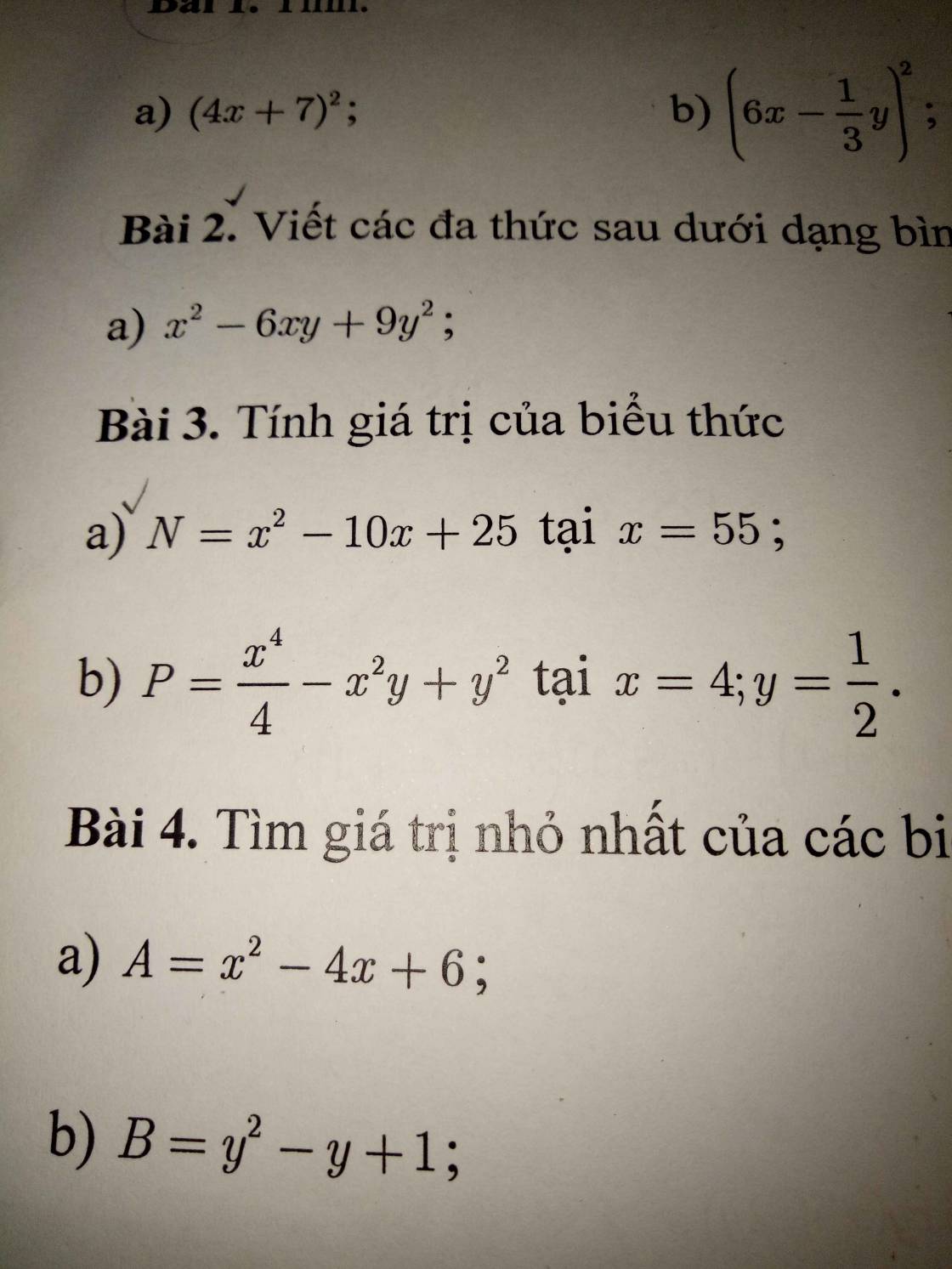Cho hình vuông ABCD. Gọi CF là tia phân giác của tam giác ADC và Q trên cạnh CD sao cho BQ vuông góc với CF. Giả sử BD, BQ cắt AC tại E, P. Chứng minh DQ = 2EP
Hãy nhập câu hỏi của bạn vào đây, nếu là tài khoản VIP, bạn sẽ được ưu tiên trả lời.



\(a,\left(2a-3\right)\left(a+1\right)+\left(a^2+6a+9\right):\left(a+3\right)\\ =2a^2-a-3+\left(a+3\right)^2:\left(a+3\right)\\ =2a^2-a-3+a+3\\ =2a^2\\ b,\left(3x-5y\right)\left(-xy\right)^2-3x^2y^2+4x^2y^3\\ =3x^3y^2-5x^2y^3-3x^2y^2+4x^2y^3\\ =3x^3y^2-3x^2y^2-x^2y^3\\ c,x\left(x-2\right)^2-\left(x+2\right)\left(x^2-2x+4\right)+4x^2\\ =x^3-4x^2+4x-x^3-8+4x^2\\ =4x-8\)

`#040911`
`a)`
`(2x - 1)^2 - (2x + 5)(2x + 1) = 10`
`\Leftrightarrow 4x^2 - 4x + 1 - (4x^2 + 12x + 5) = 10`
`\Leftrightarrow 4x^2 - 4x + 1 - 4x^2 - 12x - 5 = 10`
`\Leftrightarrow (4x^2 - 4x^2) - (4x + 12x) + (1 - 5) = 10`
`\Leftrightarrow -16x - 4 = 10`
`\Leftrightarrow -16x = 10 + 4`
`\Leftrightarrow -16x = 14`
`\Leftrightarrow x = \dfrac{-7}{8}`
Vậy, `x= \dfrac{-7}{8}`
`b)`
`9^2(x - 1) + 25(1 - x) = 0`
`\Leftrightarrow 9^2(x - 1) - 25(x - 1) = 0`
`\Leftrightarrow (x - 1)(9^2 - 25) = 0`
`\Leftrightarrow`\(\left[{}\begin{matrix}x-1=0\\9^2-5^2=0\end{matrix}\right.\)
`\Leftrightarrow`\(\left[{}\begin{matrix}x=1\\\left(9-5\right)\left(9+5\right)=0\end{matrix}\right.\)
\(\Leftrightarrow\left[{}\begin{matrix}x=1\\4\cdot14=0\end{matrix}\right.\\ \Leftrightarrow\left[{}\begin{matrix}x=1\\56=0\left(\text{vô lý}\right)\end{matrix}\right.\\ \text{Vậy, x = 1}\)
`c)`
\(x^2+3x-4=0\)
`\Leftrightarrow x^2 + 4x - x - 4 = 0`
`\Leftrightarrow (x^2 - x) + (4x - 4) = 0`
`\Leftrightarrow x(x - 1) + 4(x - 1) = 0`
`\Leftrightarrow (x + 4)(x - 1) = 0`
\(\Leftrightarrow\left[{}\begin{matrix}x+4=0\\x-1=0\end{matrix}\right.\\ \Leftrightarrow\left[{}\begin{matrix}x=-4\\x=1\end{matrix}\right.\\ \text{ Vậy, }x\in\left(-4;1\right)\)

\(1,6x-18y\\ =6\left(x-3y\right)\\ 2,-4xy^2+12x^2y\\ =-4xy\left(y-3x\right)\\ 3,5x^2y^3-25x^3y^4+10x^3y^3\\ =5x^2y^3\left(1-5xy+2x\right)\)
\(4,12x^2y-18x^2y^2-36xy^3\\ =6xy\left(2x-3xy-6y^2\right)\\ 5,10x^2\left(2x+1\right)-5x\left(2x+1\right)\\ =5x\left(2x+1\right)\left(2x-1\right)\\ 6,-28x^2\left(2x-y\right)-7x\left(y-2x\right)\\ =28x^2\left(y-2x\right)-7x\left(y-2x\right)\\ =7x\left(y-2x\right)\left(4x-1\right)\)

\(8x^3+12x^2y+6xy^2+y^3-z^3\)
\(=\left(2x+y\right)^3-z^3\)
\(=\left(2x+y-z\right)\left[4x^2+z\left(2x+y\right)+z^2\right]\)
a, 8a3 - 36a2 +54ab2 - 27b3
=(8a3-36a2b +54ab2 - 27b3)
=(2a-3b)2
=(2a-3b)(2a-3b)(2a-3b)
b, 8x3 + 12x2y + 6xy2 + y3 - z 3
=(8x3 + 12x2y + 6xy2 + y3) - z3
=(2x + y)3 - y3
=(2x + y +z) . [ (2x + Y)2 + 2(2x + y)+ z2
= (2x + y + z)(4x2 + 4xy + y2 + 4x + 2y + z2

a, 4\(x^3\).y + \(\dfrac{1}{2}\)yz
=y.(4\(x^3\) + \(\dfrac{1}{2}\)z)
b, (a2 + b2 - 5)2 - 2.(ab + 2)2
= [a2 + b2 - 5 - \(\sqrt{2}\)(ab + 2) ].[ a2 + b2 - 5 + \(\sqrt{2}\)(ab +2)]
a) \(4x^3y+\dfrac{1}{2}yz=y\left(4x^3+\dfrac{1}{2}z\right)\)
b) \(\left(a^2+b^2-5\right)^2-2.\left(ab+2\right)^2\)
\(=\left[\left(a^2+b^2-5\right)+2\left(ab+2\right)\right]\left[\left(a^2+b^2-5\right)-2\left(ab+2\right)\right]\)
\(=\left[a^2+b^2-5+2ab+4\right]\left[a^2+b^2-5-2ab-4\right]\)
\(=\left[a^2+b^2+2ab-1\right]\left[a^2+b^2-2ab-9\right]\)
\(=\left[\left(a+b\right)^2-1\right]\left[\left(a-b\right)^2-9\right]\)
\(=\left[\left(a+b+1\right)\left(a+b-1\right)\right]\left[\left(a-b+3\right)\left(a-b-3\right)\right]\)

\(\dfrac{AC}{3}=\dfrac{BC}{4}=\dfrac{AC+BC}{3+4}=\dfrac{14}{7}=2\)
\(\Rightarrow\left\{{}\begin{matrix}AC=3.2=6\\BC=4.2=8\end{matrix}\right.\)
Theo định lý Pitago cho Δ vuông ABC:
\(BC^2=AB^2+AC^2\Rightarrow AB^2=BC^2-AC^2=64-36=28\)
\(\Rightarrow AB=\sqrt[]{28}=2\sqrt[]{7}\)

